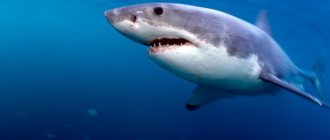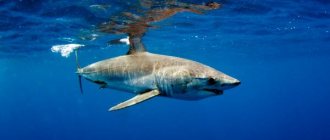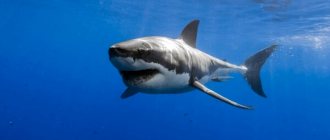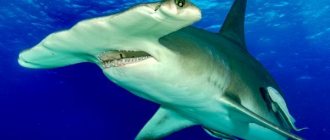Fear of sharks, instilled in a person by his subconscious, fed from myths and legends, makes him believe that the shark is the most terrible predator from which there is no salvation.
It is generally accepted that these giant fish are not only immensely bloodthirsty, but also fast like no other. Is it really? Or is the myth of the swiftness of sharks just a deception of the great eyes of our fear?
Let's find out at what speed these representatives of marine fauna can swim, and is it the same for everyone?
What picture pops up in our subconscious when we hear the word shark? Right! A huge, scary fish, cutting through the ocean at insane speed. A bared mouth, a palisade of eerie teeth, a moment, and the victim finds himself at the mercy of this ruthless predator. But in reality everything is somewhat different.
Mako shark
- Maximum length : 3.2 meters
- Maximum weight : 135 kg
- Average speed 75 km/h.
Among the shark species, the mako shark is the fastest. This species lives in temperate and tropical seas around the world. It feeds on bony fish and cephalopods. Swordfish, tuna, bonito mackerel, seabirds and sea turtles can also be caught. Speed is the main trump card when hunting, since the prey simply does not have time to notice them. When chasing prey, it is capable of jumping out of the water more than 9 meters!
Giants and shorties: about the biggest and smallest shark
We will start the list of our record holders with the largest and smallest shark. We talked about the biggest one earlier - the whale shark. Amazingly, the giant’s body can reach 20 meters in length, and the individual also weighs a lot - more than 30 tons. The giant shark is slightly smaller in size, its length is 15 meters.
www.vladtime.ru
The smallest shark is the dwarf luminescent shark. It can fit in the palm of an adult. Individuals live at great depths, so little has been studied to date.
4.bp.blogspot.com
Not all sharks are huge. There are representatives with a length from 30 to 50 cm.
Yellowfin tuna
- Maximum length : 2.4 meters
- Maximum weight : 180 kg
- Average speed: 80 km/h
Yellowfin tuna is one of the largest tuna species. It is found in all tropical and temperate latitudes of the world's oceans, but is absent in the Mediterranean Sea. It feeds on squid, crustaceans and other fish. Because of its speed and size, yellowfin tuna is also popular among sport fishermen. The record weight of trophy tuna is 193 kg. In 2010, Greenpeace added yellowfin tuna to its Red List of foods that should be avoided to avoid further harm to the ecosystem.
Interesting Facts
The secret of the high speed that fish develop in water lies in the shape of their body. It looks like a torpedo - streamlined and adapted to the enormous resistance of the liquid medium. Usually sharks swim at a speed of 8 km/h, but during the hunt they accelerate to 19 km/h, that is, they accelerate more than twice. Super-squad record holder - Mako can reach speeds of up to 50 km/h.
They also have scales, although at first glance it may seem that the body is completely smooth. Shark scales are diamond-shaped with a spike at the end. The surface of the leather feels like sandpaper. Sharp spines easily penetrate the flesh, providing the fish with reliable protection, so they have almost no enemies.
Predators breathe in the same way as other fish - with the help of oxygen, which they filter through their gills. The gills are located behind the head , but there are no gill covers on them.
However, these creatures swim differently, not like their brothers. Usually the swim bladder helps fish with this. Selachians instead have a large liver with fatty deposits, large fins and a cartilaginous skeleton. It is precisely because of the absence of a swim bladder that they must constantly move - when at rest, the fish simply drowns.
In the process of development, these fish acquired a very useful and exceptional skill - electroreception, that is, the ability to distinguish between magnetic and electrical signals. This ability is needed for hunting and interaction with other members of the species.
Due to the absence of a swim bladder, the shark must be in motion all the time.
In addition, the so-called lateral line runs along the entire body from the gill slits to the tail. It consists of sensitive receptors that perceive vibrations occurring in the environment.
The sense of smell of predatory fish is amazing - it allows selachians to detect odors not only under water, but also in the air, thanks to which these fish learn about possible prey before others.
The acuity of some types of feelings is many times greater than that of humans. The eyes of sharks are reliably protected thanks to the blinking eyelid, which closes them during an attack on the prey. At the same time, the high sensitivity of the eyes even in the dark is ensured by a special reflective layer behind the retina - a mechanism similar to the vision of a cat, which also sees well in the dark.
Another feature that has people debating whether sharks are mammals or fish. The fact is that many of them do not spawn like other fish. Among them there are several subspecies with their own methods of reproduction:
- viviparous;
- oviparous;
- ovoviviparous.
In the first species, the embryo develops directly in the female’s body until the moment when it can be born as an independent small shark. The cubs get their own food.
Oviparous sharks lay eggs that are contained in capsules. These capsules provide protection and support for the embryo for a long time.
Many shark species do not spawn like other fish, but are viviparous or egg-laying
The third species carries eggs inside its body and then gives birth to developed young.
Sharks live quite a long time - up to twenty or even thirty years. Spotted spiny sharks can reach an even more respectable age of one hundred years.
Swordfish
- Maximum length : 4.55 meters
- Maximum weight : 650 kg
- Average speed: 97 km/h
The swordfish is a predator, the upper jaw of which, in structure and size, resembles a real weapon, similar to a sword, with which the fish strikes its victims when hunting. They feed on small fish. Distributed in temperate and tropical regions of the Indian, Atlantic and Pacific oceans. Just like yellowfin tuna, swordfish is a very valuable trophy of sport fishing. They catch it by trolling. In 2010, Greenpeace added swordfish to its red list of seafood that is at high risk of overfishing, along with yellowfin tuna.
Enemies and friends
This predator has few friends. You can spot cleaner fish, stickfish and pilot fish. The former help all predators get rid of various parasites that attach to the fins and feed on skin secretions. As for enemies, makos have practically no enemies. The shark tries to avoid only its larger brothers and schooling fish. For example, if a dolphin itself can become its prey, then a school of them is able to drive away the predator from its habitat.
Sailfish
- Maximum length : 3.5 meters
- Maximum weight : 100 kg
- Average speed: 110 km/h
The second fastest fish in the world is the sailfish. A distinctive feature of the sailfish is the high and long first dorsal fin, similar to a sail. It lives in all oceans that are located in the subtropical, temperate and tropical zones. They hunt small fish such as sardines, anchovies, mackerel, and also feed on crustaceans and cephalopods.
Fishing
There is no deliberate catching of this fish; sometimes it itself gets caught in the net while chasing prey. However, you can note the delicious mako meat. This shark, like all types of herring, is suitable for food. But some internal organs and fins are of particular value. The liver of this predator is a delicacy.
Although mako is not a game fish, it is of interest to the so-called “sports hunters”. The predator fights for her life to the last, which brings a lot of emotions to the people trying to catch her. This “sport” is deadly.
There was a recorded case where a mako shark came very close to the beach and was shot with a harpoon gun. The fish freed itself from the arrow with lightning speed and rushed to attack. She jumped straight onto the sand and tried to grab the man who shot at her. He was lucky that everything worked out okay.
The worst tragedy involving a mako shark, a photo of which can be seen in this article, occurred near the Australian coast in the middle of the 20th century. Four fishermen were fishing peacefully in a large boat. Suddenly they were attacked by a flock of makos. People tried to swim to the shore, but one predator rammed right through the side of the boat and the fishermen ended up in the water. Only one was able to safely get to land; the rest were torn to pieces and eaten by bloodthirsty makos.
There has been a lot of controversy about this, and many versions have been expressed to explain the behavior of sharks. The majority was inclined to believe that people themselves provoked the attack, because they caught fish in front of the noses of feeding predators, which caused their irritation and aggression.
Black Marlin
- Maximum length : 4.65 meters
- Maximum weight : 700 kg
- Average speed: 120 km/h
Black marlin is the fastest fish in the world. Found in the Pacific and Indian oceans. It is one of the largest among marlins and bony fish. It feeds on other small fish, as well as squid and crustaceans. Black marlin got its name because of its resemblance to a pile - a large metal rod with a pointed end. It is a valuable trophy among fishermen involved in sport fishing. The largest black marlin weighed 707.6 kg and was caught by Alfred C. Glassel Jr. using a spinning rod in August 1953.
ALL LIFE IS IN MOTION
This is how sharks are designed: without moving, they suffocate even in clean water, which has enough oxygen. Pelagic sharks, that is, those living in the vast ocean, die in aquariums. Apparently, they cannot develop the required speed here. That's why they suffocate. Only at fast speed does water flow in sufficient volume through the gills of the shark. A sluggish, dying shark, if it is not too large, is placed by the aquarium attendants in a small pool with running water and, as it happens, they save its life by “washing” its gills. Sharks do not have an air bladder; their specific gravity is heavier than water. And for this reason, the shark must live in motion all the time, otherwise it will sink to the bottom as soon as it stops moving its tail.
The shark swims, bending its body in waves. The main motor impulse is imparted to the shark by its heterocercal, or, as ichthyologists say, heterocercal tail (its upper lobe in almost all sharks is longer than the lower).
Another “engine”, quite modern, has been spotted in sharks - a rocket engine! By forcefully pushing water out of the gill slits, they receive a forward thrust. Sleeping sharks usually resort to this kind of movement. Day and night, from birth to death, the shark is doomed to be on the move. But you have to sleep sometime! Nothing living exists for long without sleep and rest. Pelagic sharks, living far from the coast and over great depths, sleep fitfully afloat, from time to time slowly moving their tail and moving forward with jet thrusts, and therefore do not drown.
Coastal sharks lie down on the bottom to sleep. In shallow water, drowsy immobility does not threaten them with plunging into the ocean abyss.
The speed of the fish is measured with a stopwatch based on the speed of the ship moving on a parallel course, or with a movie camera (calculated based on filmed frames, the speed of which is known). But, perhaps, the most accurate readings about maximum speeds are given by a car speedometer mounted on a spinning rod. A fish caught on a hook, unwinding the line, usually leaves with all the agility of which it is capable. And the fishing line also quickly scrolls the speedometer connected to it.
All these methods give different speed readings. The maximum of them are (in kilometers per hour): carp - 13; perch - 17; pike - 33; salmon, barracuda, mackerel - 40; tarpon - 56; tuna - 70; swordfish, marlin and sailfish - 100-130!
What about sharks?
They are somewhere on the “mackerel-tarpon-tuna” level. The maximum recorded speed of a blue shark is 42.5 kilometers per hour, and a mako is about 60. Undoubtedly, this is a good indicator: the best horses on hippodromes gallop just as quickly.
The shark has great strength. It happened that with one jerk of a large shark, jute ropes 5 centimeters thick burst, like a thin twine!
The steel hooks stuck in the mouth unbent. The chains connecting these hooks to the fishing line can withstand a load of almost a ton. But they are also torn by sharks! They also break the hooks themselves, which are “half-inch elastic steel,” by squeezing their jaws.
Gutted, riddled with bullets, pierced more than once by harpoons, the shark is still so viable that it can bite off a hand (this happened to one fisherman). The other, also gutted and thrown into the sea, was immediately hooked again, swallowing her own intestines strung on it.
Add to this incredible vitality the teeth, sharp as knives (in large sharks up to 5 centimeters long), so sharp that you can literally shave with them. These knife teeth can bite a person in half! And the extensible shark mouth easily swallows crocodiles, sea lions, its two-meter relatives and even horses (if the mouth is very large, for example, a white shark). Don’t forget about sharks’ sensitive sense of smell and other organs,
providing accurate information and orientation in the vast expanses of the seas, and before you will appear a predatory monster, the like of which the world does not know. The shark senses a drop of blood in the “ocean” of water at a great distance, like male silkworms and saturnia butterflies, which are capable of detecting hundred thousandths of a milligram of an odorous substance in the “lake” of the atmosphere: in a space hundreds of meters wide and 3-4 kilometers long or more. Con is incredibly small - a molecule in a cubic meter of air!
“We are dealing here with such a finely developed sense of smell that the most sensitive and precise instruments with the help of which chemical analysis is carried out in our time cannot keep up with it” (A. Xezler).
The shark does not breathe through the nostrils, which are on the bottom of its snout, but only, so to speak, sniffs. Prowls in the water, determining the exact direction to the source of the smell. Whichever nostril is more intensely “bombarded” by odorous molecules is turned in that direction. If you plug your right nostril, it will always move counterclockwise to the left, towards the functioning nostril. And vice versa - clockwise, when only the right nostril catches odors.
Both nostrils were plugged - she swam past the food spreading aromas. They covered the shark’s eyes, freeing the nostrils from the plugs: “she made a stand over the food.”
Sharks, as it recently turned out, have good vision, and hearing too, but their sense of smell is their main guide.
Smell and also “distant touch,” a seismosensory sense of the lateral line that guides the fish along the correct path to the trembling prey, even if the current carries the odors away from the shark and it cannot smell them.
The lateral line is a system of sensory skin organs that stretches on each side of the body from the tail to the head (here the lateral line branches). From the main longitudinal system, small tubules (with nerves penetrating into them) extend perpendicular to the surface of the fish’s body, which sometimes open outwards. This direct contact of the sensory organs with the external environment alerts the fish to the slightest vibrations of the “outboard” water. Whether it swims up to some object or to another fish, now the additional pressure of water on the lateral line organs created by this obstacle allows it to feel the surrounding space from a distance.
Since water is a more elastic medium than air, vibrations in it propagate more than four times faster - at a speed of 1500 meters per second. This means that the lateral line receives signals about obstacles in the path and other information available to it more quickly than the ultrasonic echolocators of bats.
Sharks, perfectly equipped with everything necessary for life and action in the sea, have no doubts about the choice of food. They eat everything they can get their teeth into, even if it’s inedible and unappetizing: crocodiles, sea snakes and turtles, penguins and other birds that live above the ocean, flying fish and bottom fish (even stingrays that strike enemies with a poisonous stylet!), herring - cod, salmon - all die in the insatiable belly of the shark. Seals, dolphins, wounded whales, waste from ships, deer, horses, dogs, cats, chickens that somehow ended up in the sea, and much more even stranger are devoured and digested by sharks. Even the varnish used to cover the deck and metal objects. Horseshoes swallowed along with horse legs are digested almost as quickly as bones and hooves. Shark stomach juices have great digestive power (if they get on the skin, they cause a severe burn).
Sharks and dolphins do not have a peaceful relationship. Many dolphins die in shark teeth. But in the wild and in captivity, we have seen more than once how dolphins, attacking in a school, drove away and even killed quite large sharks. They ram them with their snout, striking them in the gill slits. Or, pressing it against the wall of the pool (or throwing it to the surface), they do not allow the shark to breathe.
Sharks do not dare to attack healthy whales. The whale, like a battering ram, is endowed with incomparably greater strength than the dolphin. But they follow the whales at a respectful distance, like jackals follow lions, so that at the right moment, when the whale is wounded, they tear it apart or pick up scraps from the sperm whale.
Author I. Akimushkin
0
Shark reproduction. How do sharks reproduce?
Sharks are distinguished by a long duration of puberty. Most females are capable of fertilization only at 10 years of age, and the whale shark becomes sexually mature at the age of 30-40 years.
Sharks are characterized by internal fertilization: some species lay eggs, others are ovoviviparous, and other types of sharks are viviparous. The incubation period depends on the species and lasts from several months to 2 years.
A clutch of oviparous sharks contains from 2 to 12 eggs. After fertilization, shark eggs are covered with a protein shell, which in turn is also covered with a horn-like shell. This allows them to be protected from various marine predators.
The hatched baby immediately begins to live and feed on its own. In sharks living in captivity, cases of parthenogenesis have been recorded - fertilization without the participation of a male individual.
Baby ovoviviparous sharks, hatched in the womb, remain for some time in the oviducts and continue to develop, first eating unfertilized eggs, and when teeth grow, their weak brothers and sisters. As a result, one, or less often two, of the strongest cubs are born. The body length of a newborn shark varies, for example, white sharks are born 155 cm long, while tiger sharks are only 51-76 cm long.











